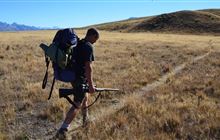Feral sheep
Introduction
Find out about feral sheep, get tips for hunting feral sheep, and find out where to hunt them.Find out about feral sheep (Ovis aries).
Description
Size: Variable depending on breed. Males up to 780 mm at shoulder height and weighing as much as 66 kg, females about 700 mm shoulder height and 40-60 kg.
Colour: As with size, colour varies with the population breed and can be white, dark brown to black or parti-coloured.
Horns: Both sexes may carry horns. Female horns are slender, erect and curving backwards where in males the horns are much larger curving back and spiralling outwards for up to two turns.
Some sheep of both sexes instead of visible horns may have 'scurs' which are small horny growths on the frontal bones often hidden in wool and not visible.
Social behaviour: Feral sheep are grazers feeding throughout the day on pasture and herbaceous plants. Areas occupied usually contain rough pasture and shelter in the form of broken scrub or forest. Females and their young stay together as a pair while males in the non-breeding season may form small groups.
When disturbed feral sheep run for cover, whereas domestic sheep tend to run into the open.
Reproduction: Breeding can cover a long period peaking in June and July.
Gestation period: 150 days.
Birthing: Any time but mostly July to September. March in some populations. Twins are rare in wild populations.
Nomenclature: Male = ram. Female = ewe. Young = lamb.
Where to hunt feral sheep
Find a hunting block that has feral sheep
You can use the hunting block search function to find hunting areas on conservation land that have feral sheep.
Search for a hunting block that has feral sheeps.
Private property
There are 11 individual populations of feral sheep recognised (8 on mainland and 3 on islands) and most occur on private property.
The following information shows differences between flocks available on DOC's permit system and those that require private owner permission.
You must get a hunting permit from a DOC office to hunt feral sheep: Permits must be obtained from the office closest to the population being hunted, they are not covered by the online permit system.
North Island
- Mohaka Valley: Fragmented flock mostly on private property some in Kaweka Forest Park.
- Ngaruroro River Valley: Small numbers mostly on private property some in Kaweka Forest Park.
South Island
- Waimakariri River Valley: Small numbers on private property.
- Waianakarua River Valley: Hunting available in Waianakarua Scenic Reserve, coastal Otago north of Catlins. DOC permit required.
- Waipori Gorge
- Hokonui Hills: Small number on private property.
Islands (accessible to hunting)
- Arapawa Island: Hunting opportunities for Arapawa sourced animals on game reserves by professional guides only.
- Chatham and Pitt Islands. Hunting opportunities on private property by professional guides available for both islands.
Tips for hunting feral sheep
|
Characteristics/behaviour |
Hunting response |
|---|---|
|
Feral sheep are medium sized animals often covered in thick woollen fleece. |
Use rifle calibre with good hitting energy e.g. .243 minimum. |
|
Feeding can occur throughout the day. |
Hunt cautiously and expect to see sheep actively feeding at any time of the day. |
|
Outside breeding season rams may form groups. |
When hunting rams for trophy horns, use patience and watch a mob for a while to identify the best trophy. |
|
Feral sheep are usually found in flocks and can be extremely wary. |
When sheep are encountered take time to check for other sheep not initially seen and if stalking a ram be careful of avoiding other sheep. |
|
Feral sheep have horns that continue to grow - they are not shed annually like antlers of deer. |
Trophy hunting for feral rams can occur at any time of the year. |
Hunting seasons and ballots
In New Zealand, there is no seasonal restriction to hunting feral sheep meaning generally they can be hunted throughout the year. There are however, instances where restrictions apply for specific reasons and periods when hunting is favoured.
Specific restrictions
- Some areas may be closed during periods of high fire danger.
- Not a common occurrence but an area may be closed on a temporary basis to enable research or other management to be undertaken without being compromised by hunting.
It is important to check for these conditions with the DOC office closest to the population being hunted.
International travel with hunting trophies
You may need CITES documentation to enter or leave New Zealand with your hunting trophy.

